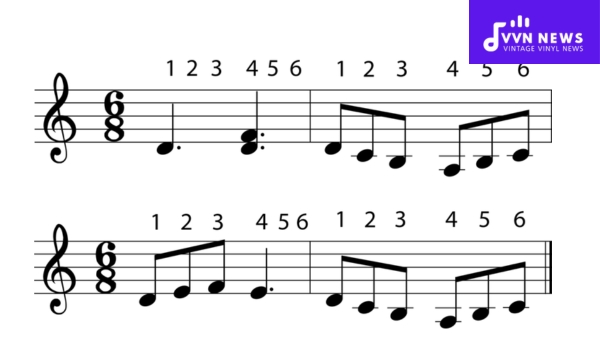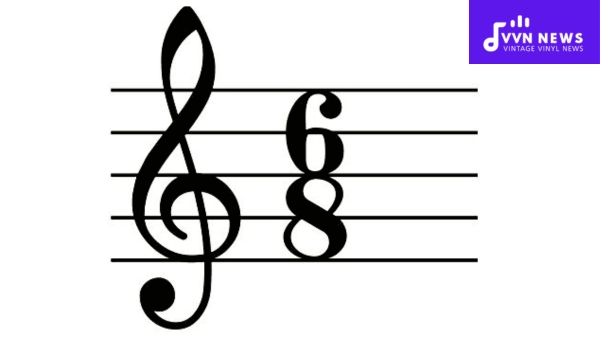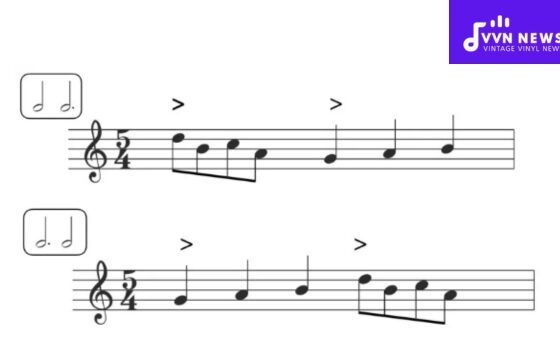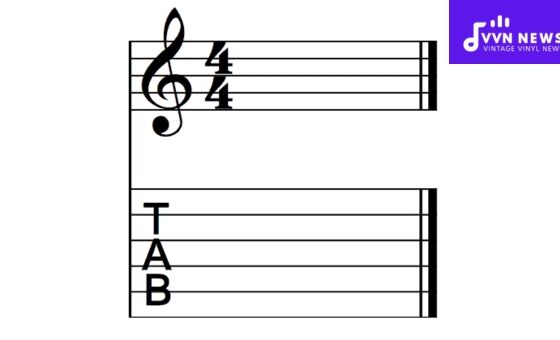Music serves as the heart’s journal, and within this world of rhythm and symphony, certain codes describe our diverse musical journeys.
One such intriguing code is known as the “time signature 6/8”. It’s a melody maker that has been captivating people for centuries and continues to do just that.
This post will guide you through the magical realm of this distinctive time signature. The term may sound technical to some, but once you understand it, you’ll liberate your imagination in entirely new ways when listening to or creating music.
The time signature 6/8 invites us into a waltz-like dimension where beats hold a different sway.
So let’s begin our voyage into the world of 6/8, an emblematic aspect of musical composition that offers both an unusual character and also a rhythmic opportunity to let your creativity flow unhindered.
What Is a Time Signature 6/8?
A 6/8 time signature is not as complicated as it might initially seem. It represents a distinctive rhythm structure in musical notation, distinguishing how many beats are in each measure and what kind of note gets the beat.
The upper number ‘6’ indicates that there are six beats in a measure, while the lower number ‘8’ signifies that an eighth note gets one beat.
Simply put, a measure of music played in 6/8 time will have six-eighth notes. You could say it’s like having six heartbeats, with each tap of the foot or nod of the head marking an eighth note.
With this rhythm engraved on your mind, encountering music sheets bearing the 6/8 signature won’t leave you perplexed anymore.
A striking aspect of this time signature is it provides a rich palette for musical expression that differs greatly from other common ones such as 4/4 (four-quarter notes per measure) or 3/4 (three-quarter notes per measure).
You’ll often find it employed in musical genres that require a unique rhythmical feel or accents, imbuing melodies with an extraordinary swing that’s hard to resist!
Also Read: A Minor Scale [Unlock The Mysteries Of Musical Composition]
How Does Time Signature 6/8 Differ from Other Time Signatures?
In the world of music, 6/8 holds a distinctive character that sets it apart from its fellow time signatures.

Pivotal to this difference is how the beats are grouped and which beats receive emphasis.
Compound Time vs Simple Time
The primary separation comes with its classification as compound duple time.
Most common time signatures like 4/4 or 2/4 fall under simple time, meaning they can be subdivided into two equal parts.
In contrast, each beat in a compound time like 6/8 splits into three subdivisions—this inherently changes the rhythmic feeling it creates.
Beat Grouping and Emphasis
Imagine if you will, six eighth notes in a measure. In 4/4 (common time), we’d stress every second eighth note, giving us a “strong-weak” sensation for each beat.
But in 6/8, we emphasize the first and fourth eighth notes, shaping a “strong-weak-weak-strong-weak-weak” rhythm pattern that provides a lilting, rolling feel.
Placement in Musical Scores
On a musical score, while 4/4 makes one envision marching soldiers with its steady pulse; 6/8 ingrains an image of dancers swaying gracefully.
You’d find chunkier note groupings in other signatures which isn’t the case with 6/8’s flowing movement.
With such distinctive traits, recognizing this signature within any composition becomes easier.
It’s used frequently to evoke feelings of movement and dance-like qualities that you won’t achieve with say, 3/4 (which is closer to a standard waltz) or the primal steadiness of 2/2.
What Are the Basics of Counting in 6/8 Time?
When delving into the essentials of counting in 6/8 time, it’s important to note that this time signature is compound duple.
This means each measure consists of two primary beats divided into three sub-beats, creating a rhythmic flow that often feels like a rolling waltz.
Step-by-Step Counting:
- Visualize two main beats per measure. In your mind, see these as the pillars that structure the rhythm.
- Within each beat, subdivide into three smaller pulses. Think of saying “1-2-3” for the first beat and “4-5-6” for the second.
- Rather than evenly spaced beats found in simple time signatures, accentuate the first and the fourth pulses to emphasize their lead—the rhythmic heartbeat.
- Practice tapping these counts out loud or with your foot: “ONE-two-three-FOUR-five-six”—capitalizing on those key beats.
Remember that while there are six pulses, you’re primarily feeling two broader waves of rhythm within each bar of music—each carrying its triplet grouping.
Focus on how pieces befittingly harness this signature’s flowing nature, where you’ll notice how they hold space for dynamic expressions and delicate rhythmic nuances—all sprouting from those foundational counts: one through six.
Also Read: F Sharp Minor Pentatonic Scale [How To Use In Your Compositions]
When Is 6/8 Time Signature Typically Used?
Musicians often gravitate toward the 6/8 time signature when they aim to evoke a sense of smoothness and flow.

You’ll find that this compound meter is typically utilized in music genres where a lilting quality is preferred or where musicians want to create the feel of two groups of three beats.
- Classical Music: In the realm of classical music, pieces like the Dance of the Sugar Plum Fairy from Tchaikovsky’s The Nutcracker showcase how 6/8 can conjure an ethereal and delicate atmosphere.
- Folk Music: This time signature is deeply rooted in folk traditions across the globe. The traditional Celtic jig, for example, relies on it to deliver its characteristic bounce and lively spirit.
- Pop and Rock Ballads: Modern popular music often uses 6/8 to lend ballads an enticing sway. It’s not uncommon for power ballads or rock anthems to take advantage of this rhythmic structure for their more emotive segments.
- Jazz: Jazz compositions sometimes employ 6/8 for a smoother narrative in their storytelling, allowing improvised solos to ride the waves of this rolling beat.
Not confined solely to these examples, 6/8 also appears frequently in gospel music, certain R&B songs, and even movie soundtracks where composers are painting an auditory scene that requires a flowing continuity.
Musicians select 6/8 times when they desire a rhythm that can both gracefully undulate and maintain forward momentum.
The next time you encounter a piece set in this meter, pay attention to the mood it conveys – chances are, it’s harnessing the intrinsic traits of 6/8 to weave its spell.
How to Recognize 6/8 Time in Music Scores
When reading music scores, identifying a 6/8 time signature is straightforward once you know what to look for:
- Locate the Time Signature: At the beginning of a piece, after the clef and key signature, you’ll find two numbers stacked vertically—this is the time signature.
- Interpret the Numbers: In 6/8, the top number ‘6’ denotes there are six beats per measure. The bottom ‘8’ indicates that these beats are eighth notes.
- Examine Note Groupings: Groups of notes will often be clustered in sets of three eighth notes to facilitate easier reading and playing. This visual cue helps performers internalize the compound meter typical of 6/8 time.
- Tempo Markings complement time signatures: A piece with a 6/8 marking might also include tempo indications like “dotted quarter note = 60,” reinforcing that two sets of three eighth notes fit into each measure at that tempo.
Remember to look for these specific details on your score, and you’ll confidently pinpoint pieces composed in this enchanting 6/8 meter.
Also Read: F Sharp Minor Pentatonic Scale [How To Use In Your Compositions]
What Are Common Rhythmic Patterns in 6/8 Time?
In a 6/8 time signature, the rhythmic patterns flow with a compound pulse; typically, two main beats per measure are divided into three equal parts.

Imagine these beats as rolling waves – the first is stronger (downbeat), creating a lilting sensation.
Common patterns include:
- A straight flow of six eighth notes (quavers), where you would stress the first and fourth beats for that characteristic 1-2-3, 4-5-6 feel.
- Variations of dotted quarter notes followed by an eighth note, which gives a long-short rhythm. This would manifest as 1 (hold), 2, 3, 4 (hold).
To delve deeper into these patterns, you can explore music that effectively utilizes the 6/8 meter for practical examples.
Famous Pieces Written in 6/8 Time
The 6/8 time signature, often associated with a swinging or lilting rhythm, has been a favorite among composers and songwriters across various genres.
This meter gives a piece a distinctive “two beats per measure” feel—each with a triplet subdivision—creating an almost flowing sensation that’s hard to miss.
Discover some iconic musical compositions that have harnessed the charm of 6/8 time.
Classical Masterpieces
In the classical realm, Johannes Brahms‘s “Intermezzo in B-flat minor”, Op. 117, No. 2, stands as a testament to the emotional depth achievable with this time signature. The piece flows with tenderness and introspection.
Ludwig van Beethoven embraced 6/8 in his celebrated “Pastoral Symphony” (Symphony No. 6), specifically in the final movement titled ‘Shepherd’s Song.
Cheerful and thankful feelings after the storm. This segment evokes pastoral joy and is indicative of natural patterns, embodying the tranquility following turbulence.
Rock & Pop Anthems
The rock pantheon has its share of 6/8 anthems too. Led Zeppelin‘s “Since I’ve Been Loving You” employs this meter effectively, oozing bluesy swagger that underlines every guitar riff and vocal wail with an irresistible groove.
From the pop music scene, we draw attention to Adele‘s powerful ballad “Someone Like You“.
The poignant melody draped over steady yet gentle rhythmic pulses propels the song into listeners’ hearts.
Folk & Ballads
Notably within folk traditions, where storytelling melds closely with music, there’s Simon & Garfunkel‘s haunting tune “Scarborough Fair/Canticle“.
The gentle sway of this signature cascades through their harmonies and intricate counter melodies.
“House of the Rising Sun” as performed by The Animals also deserves mention for its timeless narrative quality heightened by its rhythmic structure—a classic story told atop a quintessential 6/8 meter.
From orchestral symphonies to iconic rock solos and introspective ballads to storytelling folk tunes – these pieces illustrate how artists across decades have employed 6/8 time signatures to convey varying emotions and narratives within their music.
This versatility ensures that each composition remains etched in memory due significantly to its unique rhythmic heartbeats.
Also Read: Transposition Chart [A Lifesaver For All Musicians]
FAQs
What distinguishes 6/8 time from common time signatures like 4/4 or 3/4?
In 6/8 time, you’re grouping notes into two sets of three eighth notes, giving a “two” feel with a triplet pulse, while in 4/4 or 3/4, the beats are typically even.
Can I mix different time signatures in a single piece of music?
Yes, composers often switch between different time signatures within a piece to add variety and complexity.
Is it possible to have a song with both vocal and instrumental parts in different time signatures?
While unusual, it is possible; this is known as a polymeter, where two or more rhythmic layers have different meters.
Does playing in 6/8 require a specific technique for any instruments?
Not necessarily, but some percussion patterns might change to accommodate the inherent triplet feel of the signature.
Are there genres that predominantly feature songs in 6/8?
Yes, genres such as Irish folk music and certain ballads frequently employ the rolling rhythm of the 6/8 time signature.
Also Read: Mastering Chords In A Minor [Improve Your Composition Skills]
Conclusion
The 6/8 time signature offers a unique rhythmic sensation that is both compelling and expressive. Its distinct flow sets it apart from other meters, creating an ambiance of sway and poise in the music it influences.
As you embark on your musical adventures, keep an ear out for the subtle but spirited pulse of 6/8.
Whether you’re listening intently to masterpieces or crafting your compositions, learning this time signature can elevate your appreciation and proficiency in the musical arts.
Embrace its allure, and let the 6/8 infuse your melodies with its enchanting cadence.








